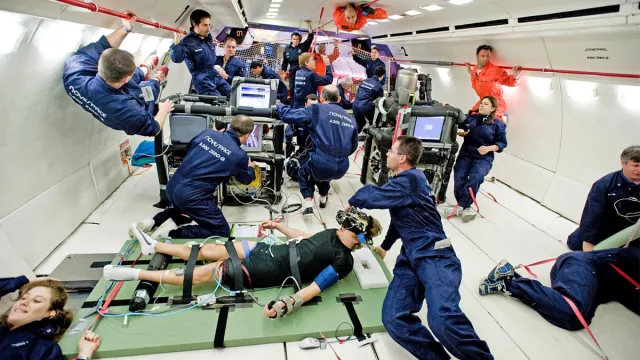With the Airbus A310 Zero G operated by its subsidiary Novespace, CNES possesses an ideal and inexpensive way to perform microgravity science. Experiments in microgravity conditions also serve to test out systems and equipment before sending them into space.
Key information
| Mission | Observe physical, chemical and physiological phenomena in weightless conditions, test science and technology experiments on parabolic flights |
|---|---|
| Domain | Science |
| Start date | 1988 |
| Partners | Novespace |
| Where | Airbus A310 Zero G |
| Lifetime | Indefinite |
| Status | In operation |
Key figures
- 22 seconds of weightlessness
- 3 hrs: duration of flight in Zero G aircraft
- 31 parabolas flown per day
- 100 m²: cabin area available for experiments
Key milestones
- 2019: 30 years of parabolic flights and new livery for A310 Zero G aircraft
- 5 May 2015: A310 Zero G makes first parabolic flight for scientific research
- June 2014: Novespace buys Airbus A310 and outfits it as A310 Zero G
- 2013: Creation of AirZeroG brand to market zero-g flights
- 1995: Novespace buys Airbus A300 and outfits it as A300 Zero G
- 1986-1995: Science campaigns organized on Caravelle Zero G at Brétigny flight test centre
- 8 July 1986: CNES creates Novespace subsidiary
Project in brief
The Airbus A310 Zero G operated by CNES subsidiary Novespace is no ordinary aircraft. It recreates weightless conditions for 22 seconds at a time, so passengers can observe physical and physiological phenomena otherwise masked by gravity on the ground, only at much lower cost than in space. For example, scientists can study how the human heart works, how neurosensory perception adapts to weightlessness, analyse fluid properties or observe how a material behaves at high temperature. Such experiments also serve to test out systems and equipment before sending them into space.
To create these weightless conditions, the A310 Zero G flies a series of 30 bell-shaped parabolic trajectories on each sortie. Specially fitted out for this type of flight, the aircraft is used by CNES for its parabolic flight programme, initiated in 1988. Every year, CNES conducts two parabolic flight campaigns, each comprising three flights. Each flight carries a dozen science and technology experiments. The A310 Zero G also flies parabolas simulating lunar and Martian low-gravity conditions to prepare for future exploration missions to the Moon and Mars.
CNES’s role
Novespace is a subsidiary of CNES formed in 1988 and the owner of the A310 Zero G aircraft, which it operates in collaboration with European space agencies and maintains with Sabena Technics. Novespace outfitted the A310 Zero G and is in charge of overall organization of the programme, marketing and operational planning of flight campaigns.
Novespace’s customers are space agencies. For CNES things are a little different, since Novespace is a subsidiary of the agency. ESA and CNES organize two flight campaigns a year (in spring and in autumn for CNES). DLR organizes three campaigns every two years. International customers include the U.S. space agency NASA and the Japanese space agency JAXA.
Since 2013, a new entity has joined the programme. AirZeroG markets discovery flights in weightless conditions, allowing enthusiasts to feel what gravity is like on the Moon or Mars, and the weightlessness of space as the aircraft flies 15 parabolas.
Flight campaigns are organized in France for research laboratories, notably those attached to the national scientific research centre CNRS, the French national institute for health and medical research Inserm or universities.
The CADMOS centre for the development of microgravity applications and space operations is in charge of organizing CNES flight campaigns, with a team of subject matter experts that help to select experiments and research laboratories. CADMOS selects experiments and tracks their development with Novespace, and provides support to load experiments aboard the aircraft and perform them. CADMOS’s expertise in microgravity research is invaluable in supporting development of experiments.
Contacts
Parabolic Flights Project Leader
Sébastien Rouquette
E-mail: sebastien.rouquette at cnes.fr
Head of Exploration Science
Jean Blouvac
E-mail: jean.blouvac at cnes.fr


